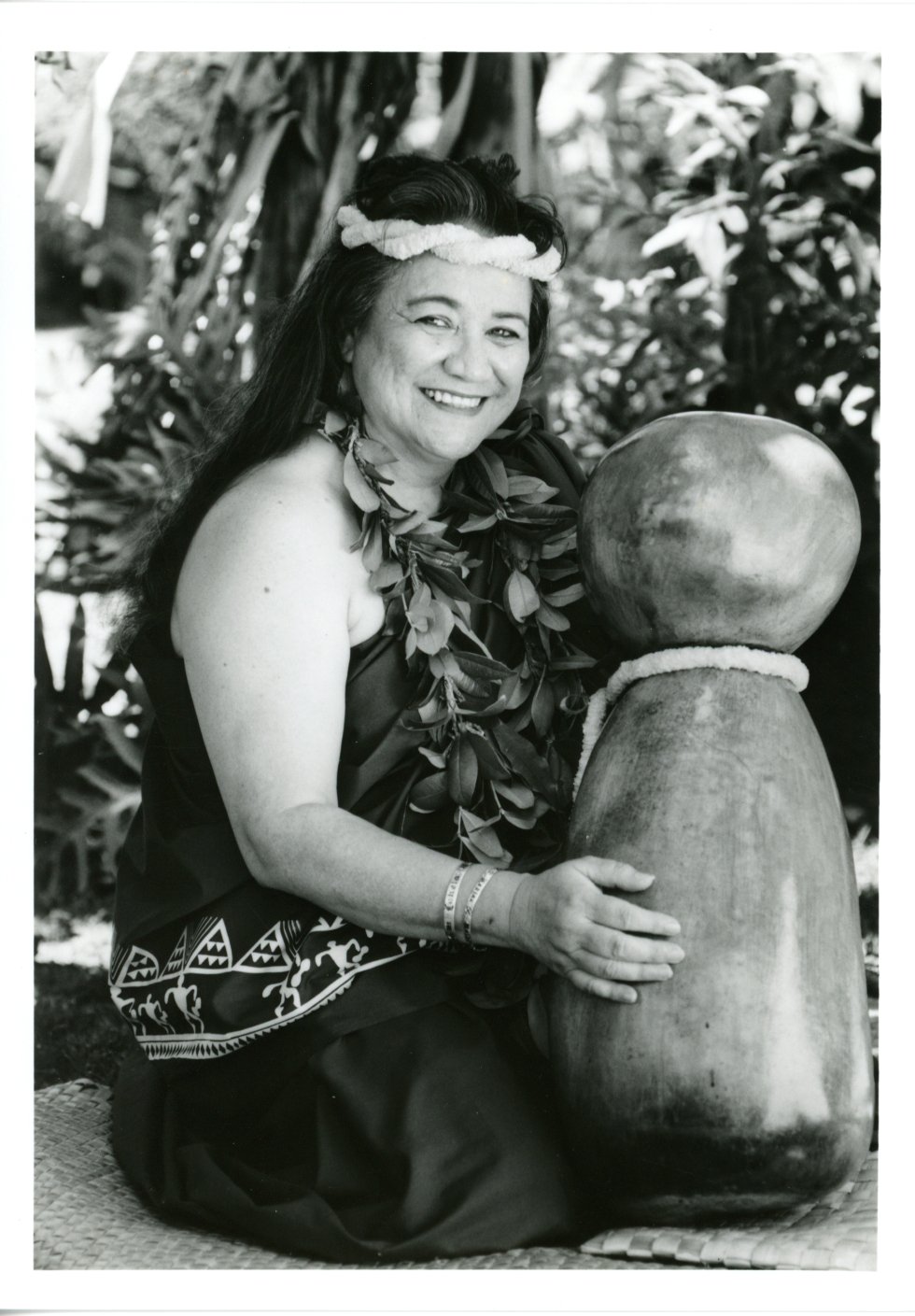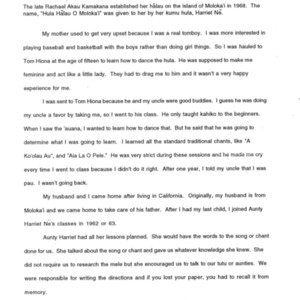Rachael Akau Kamakana
Title
Rachael Akau Kamakana
Subject
Nā Kumu Hula Rachael Akuu Kamakana - Nānā I Nā Loea Hula Volume 2 Page 52
Description
The late Rachael Kamakana established her hālau on the island of Molokai in I968. The name Hula Hālau O Molokaʻi was given to her by her kumu hula Harriet Nē.
My mother used to get very upset because I was a real tomboy. I was more interested in playing baseball and basketball with the boys rather than doing girl things. So I was hauled to Tom Hiona at the age of fifteen to learn how to dance the hula. He was supposed to make me feminine and act like a little lady. They had to drag me to him and it wasn’t a very happy experience for me.
I was sent to Tom Hiona because he and my uncle were good buddies. He was doing my uncle a favor by taking me, so I went to his class. I wanted to learn how to dance ‘auana but he said that he would determine what I was going to learn and he only taught kahiko to beginners. I learned all the standard traditional chants like “A Ko‘olau An” and “Aia Lā 'O Pele.” He was very strict during these sessions and he made me cry every time I went to class because I didn’t do it right. After one year I told my uncle that I was pau.
I didn’t return to hula until my husband and I came home to Molokaʻi to take care of his father. After I had my last child, I joined Aunty Harriet Nē’s classes in 1962. Aunty Harriet had all her lessons planned. She would have the words to the song or chant done for us. She talked about the song or chant and gave us whatever knowledge she knew. She did not require us to research the mele but she encouraged us to talk to our tūtū and aunties. We were responsible for writing the directions and if you lost your paper, you had to recall it from memory.
After about three years she held an ʻūniki: a completion for those lessons given to us. Although we had no paper or certificate, she said it was the old way where she brought witnesses to see that you had completed a certain part of the training.
Aunty Harriet was pleased that we had completed the ‘ūniki and she continued to prepare us to become kumu hula. She gave us certain chants and mele to research. We had to teach the basic fundamental steps and a hula number to a new student. She would also require us to do demonstrations at a moment’s notice.
Under the State Foundation on Culture and t he Arts, Aunty Hoakalei Kamau‘u started a training program to develop kumu hula in the community. They contacted Aunty Harriet because she was known as the historian for Molokaʻi. She called me and encouraged me to join the program.
When I got involved in the class, one of the conditions of receiving the training was that we would have to teach for free in the community for one year. I fulfilled my commitment by teaching on Molokaʻi. However when I finished, there was a great response for me to continue to have classes. I talked with Aunty Harriet about opening a school and she thought it was a wonderful idea.
To tell you the truth, I never wanted to be a teacher. I wanted to dance my life away. I saw myself as going from teacher to teacher, just learning and having a wonderful time. But once I started to teach, I was besieged by people who really wanted to learn.
To me the language is the important key. It is the key to understanding. The key that can better define a feeling, a sense, and a thought.
My greatest accomplishment as a hula teacher is the experience of teaching. I have had to learn to do research and learn all the different aspects of the culture. Now I am able to transmit this information to others.
My mother used to get very upset because I was a real tomboy. I was more interested in playing baseball and basketball with the boys rather than doing girl things. So I was hauled to Tom Hiona at the age of fifteen to learn how to dance the hula. He was supposed to make me feminine and act like a little lady. They had to drag me to him and it wasn’t a very happy experience for me.
I was sent to Tom Hiona because he and my uncle were good buddies. He was doing my uncle a favor by taking me, so I went to his class. I wanted to learn how to dance ‘auana but he said that he would determine what I was going to learn and he only taught kahiko to beginners. I learned all the standard traditional chants like “A Ko‘olau An” and “Aia Lā 'O Pele.” He was very strict during these sessions and he made me cry every time I went to class because I didn’t do it right. After one year I told my uncle that I was pau.
I didn’t return to hula until my husband and I came home to Molokaʻi to take care of his father. After I had my last child, I joined Aunty Harriet Nē’s classes in 1962. Aunty Harriet had all her lessons planned. She would have the words to the song or chant done for us. She talked about the song or chant and gave us whatever knowledge she knew. She did not require us to research the mele but she encouraged us to talk to our tūtū and aunties. We were responsible for writing the directions and if you lost your paper, you had to recall it from memory.
After about three years she held an ʻūniki: a completion for those lessons given to us. Although we had no paper or certificate, she said it was the old way where she brought witnesses to see that you had completed a certain part of the training.
Aunty Harriet was pleased that we had completed the ‘ūniki and she continued to prepare us to become kumu hula. She gave us certain chants and mele to research. We had to teach the basic fundamental steps and a hula number to a new student. She would also require us to do demonstrations at a moment’s notice.
Under the State Foundation on Culture and t he Arts, Aunty Hoakalei Kamau‘u started a training program to develop kumu hula in the community. They contacted Aunty Harriet because she was known as the historian for Molokaʻi. She called me and encouraged me to join the program.
When I got involved in the class, one of the conditions of receiving the training was that we would have to teach for free in the community for one year. I fulfilled my commitment by teaching on Molokaʻi. However when I finished, there was a great response for me to continue to have classes. I talked with Aunty Harriet about opening a school and she thought it was a wonderful idea.
To tell you the truth, I never wanted to be a teacher. I wanted to dance my life away. I saw myself as going from teacher to teacher, just learning and having a wonderful time. But once I started to teach, I was besieged by people who really wanted to learn.
To me the language is the important key. It is the key to understanding. The key that can better define a feeling, a sense, and a thought.
My greatest accomplishment as a hula teacher is the experience of teaching. I have had to learn to do research and learn all the different aspects of the culture. Now I am able to transmit this information to others.
Citation
“Rachael Akau Kamakana,” Nā Kumu Hula Archive, accessed August 25, 2025, https://nakumuhula.org/archive/items/show/124.










